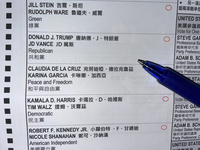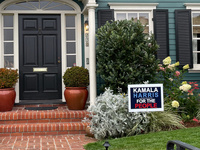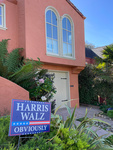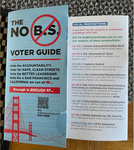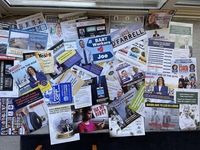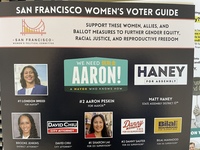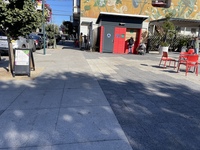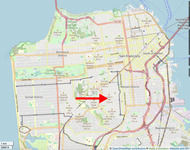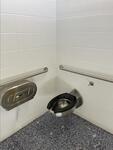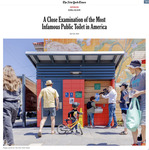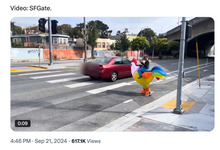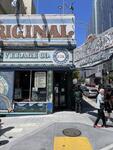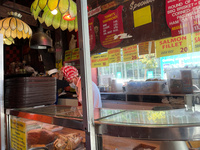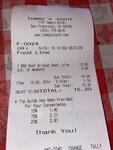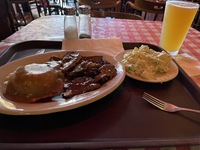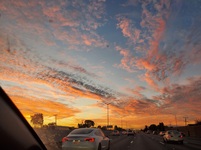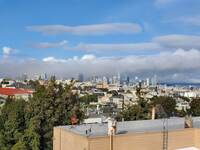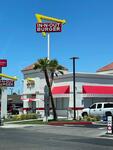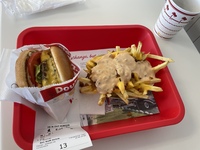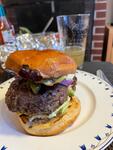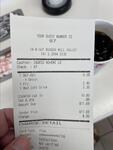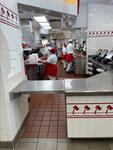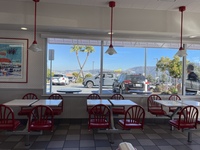 |
| Angelika/Mike Schilli |
Angelika The USA is in the final stages of the election campaign, and newspaper writers are typing their fingers to the bone. We are already quite exhausted from all the debates, analyses, and forecasts. Many have asked us for our assessment since we live in this country. Who will win, Harris or Trump? This may sound a bit offhand, but the chances are still 50-50 for both. We can't provide any smarter analyses either. It's very close. The decision for Biden to step aside in July was necessary and important, but unfortunately, it came a bit too late. I would have at least wished for an open Democratic convention where not only Kamala Harris was nominated, but also other candidates, for whom the delegates could have cast their votes. But no one asks me.
And it's not about convincing the Democratic voters in California or New York, but rather the undecided ones in the middle of the country. And Kamala Harris is, after all, associated with Biden's policies and, as Vice President, had extremely low approval ratings in polls at times. However, these have since improved and are now just under 50%. According to the New York Times, one in six voters still did not know in October for whom they would cast their vote on November 5th. This group also includes voters who ultimately decide not to vote at all because they cannot warm up to either Harris or Trump, or who, in protest, write in a joke candidate on the ballot. Interestingly, Robert Kennedy's name is still on the California ballots, even though he officially withdrew his candidacy, but the ballots had already been printed.
Our voter ballots are already on our living room table because in California, since the pandemic, we automatically receive mail-in voting materials. We also have piles of pamphlets accumulating in our apartment, and every day I receive text messages asking me to donate to Kamala Harris. I have no idea where they got my mobile number. In these text messages, I'm often addressed as Henry. Hmm.
Living in an already decided state, we never get presidential campaign advertisements. The brochures that clog our mailbox daily are about the local elections, because in California and San Francisco, voters can once again decide on numerous propositions. And there's a mayoral election in San Francisco, which the international press isn't reporting on because the presidential election is too much in the spotlight.
Actually, we were supposed to have the mayoral election in November 2023, but with the passing of Proposition H in 2022, voters decided that mayoral elections should now always coincide with presidential elections, as it is hoped this will lead to higher voter turnout. San Francisco has been grappling with several issues for quite some time. Downtown has been desolate since the pandemic and just isn't recovering. The crime rate is high, with break-ins in homes and cars, large-scale shoplifting, homeless tent cities on sidewalks, and the fentanyl crisis significantly reducing the quality of life for many in the city. Many voters are fed up with the status quo and want change.
Politics in this city is indeed complicated. Ultimately, there is no opposition in the city council; instead, politicians are categorized as either moderate or left-leaning Democrats. It should be noted that by San Francisco standards, a moderate Democrat here would probably be considered a leftist in other parts of the USA. Politicians in San Francisco also frequently struggle with accusations of corruption. There is an inflated bureaucratic jungle and little oversight to ensure that tax dollars are used as intended.
And that's not all: In addition to the President of the USA and the Mayor of San Francisco, a good dozen other offices are also up for election: Among others, the sheriff, the chairpersons of the school board, the director of the subway (BART), and several city council members, who will only receive votes from voters residing in their respective districts.
Angelika San Francisco has an interesting voting system, namely the so-called "Ranked Choice Voting". Roughly and simply put, the voter ranks all the candidates in order of preference. The candidate they like the most is placed first, the second choice in second place, and so on. This initially sounds simple, but it has its pitfalls, as I will explain in more detail shortly. Such an election process prevents run-off elections, but it is often criticized as being too complicated or opaque.
But how exactly does it work in San Francisco? The voter can rank up to 10 candidates in order of preference. In our mayoral election this year, there are 13 candidates running. However, the ranking stops at 10. Each eligible voter can rank as many (up to 10) or as few candidates as they wish. Each candidate must have a different ranking on the ballot, and the same candidate can only receive one ranking.
How is the counting done? First, it is counted how many times each individual candidate has landed in first place among the voters. If a candidate achieves the majority in this round (i.e., more than 50%), that candidate wins. The counting is then finished. If there is no winner after this first round of counting, the candidate with the fewest votes is eliminated. If a voter had indicated this candidate as their first choice, their second preference is then counted as their new first choice.
If a candidate receives more than 50% in the second round, that candidate wins and the counting is also concluded. If there is no winner again in the second round, the candidate with the fewest votes is eliminated once more, and the rankings are adjusted accordingly. This process continues until a winner is determined.
In theory, that sounds logical, but the counting method relies on the voter actually providing a complete ranking ladder. If a voter, for example, only chooses one candidate who is eliminated in the first round, the vote is lost. This can potentially lead to a candidate winning who was not generally favored and who wins with less than 50% of the votes, due to the previously explained principle of exhausted ballots. For example, if 200 ballots were cast and 80 of them are exhausted due to a lack of rankings for the remaining candidates, a candidate could win with 61 votes. That is more than 50% of the remaining 120 ballots, but 30.5% of all originally cast ballots.
Who is now entering the race for San Francisco? Out of the list of 13, only 5 are really to be taken seriously. First, there's our current mayor, London Breed, who wants to try again. Then there's Mark Farrell, who served on the city council from 2010 to 2018 and acted as interim mayor for half a year in 2018 after the death of the then-incumbent mayor, Ed Lee. Additionally, there's Ahsha Safaí, also a supervisor on the city council. Then there's Aaron Peskin, who has shaped city politics on the council for decades and currently serves as its chair. He has the nickname "Napoleon of North Beach," after the name of the neighborhood where he lives. He presents himself as particularly left-liberal but only has his own interests in mind. For example, he claims to support the creation of housing in San Francisco but consistently blocks construction projects in his district. He also campaigned on the need for political change in San Francisco, even though he has been part of the system for over 20 years as an influential supervisor on the city council. As a voter, you can't help but feel a bit taken for a ride. Unfortunately, we still see his campaign posters hanging in many windows.
And then there is the political outsider Daniel Lurie, who has not held any political office to date, but is connected to a very well-known San Francisco family, namely that of Levi Strauss. I'm sure you all know who Levi Strauss is. The man delighted the world with the legendary Levi's jeans. Daniel Lurie has pumped several million of his own fortune into the election campaign, and it seems to be paying off, as he is now mixing it up at the forefront. We've been receiving brochures from Lurie in our mailbox almost every day.
For the mayoral election in San Francisco, we expect that the winner will not be determined after the first round, but rather that the votes will be mainly distributed among Breed, Farrell, Lurie, and Peskin. It remains exciting on all levels.
Michael Our neighborhood, Noe Valley in San Francisco, is known to be almost at the center of the peninsula on which the city spreads out. However, hardly any tourist knows about our little oasis, a well-preserved small village with its own marketplace, amidst a decaying city where chaos has reigned for years due to misguided policies.
On our town square, a weekly market now takes place every Saturday, where farmers from the surrounding area sell high-quality organic goods to a well-to-do clientele. During the week, there are small tables with chairs on the square, where, strangely enough, you hardly see any homeless people lingering. Instead, it seems to be frequented only by the higher-earning city crowd, who apparently take a break after strolling through the fashion boutiques on 24th Street. Amazingly well-behaved children are playing under the supervision of their nannies on the slide of the playground.
An idyll, a jewel of urban planning! Only one thing was missing until recently: a public toilet, as the surrounding restaurants generally only allow guests to use their facilities for cost reasons. It so happened that in 2018, the then-supervisor Matt Haney pulled a plan out of his pocket to build the toilet. But of course, a simple portable toilet cannot stand in the prestigious marketplace of Noe Valley; we're not at the Wacken Open Air heavy metal festival! So, several designs were solicited, and the best one was selected and approved.
The fact that the planned 20-square-meter monument to detoxification was now supposed to cost a whopping 1.7 million dollars did not deter Supervisor Haney, because, as is well known, our city requires 42 paid permits for every little thing, and for any construction project, 17 different unions have their hands out. This may seem grotesque to you now, but in San Francisco, the Department of Public Works, the Mayor's Office on Disability, the Arts Commission, the electricity provider (PG&E), the city planning committee, and many other organizations actually charge exorbitant fees for opaque paperwork and assessments before such a project even takes shape. Furthermore, by law, only highly qualified union workers are allowed to carry out the construction work.
Nevertheless, Matt Haney had already organized the 1.7 million, with the money set to come from the city and state tax coffers, and the project was, as they say, in the bag. Matt Haney had since made a career move, rising from city council to become a government representative in Sacramento. Surprisingly, however, our otherwise not at all stingy Governor Gavin Newsom found the toilet costs to be exorbitant and abruptly cut the state of California's involvement. This put the project on hold for the time being. A wild hunt for sponsors began, and a toilet company from Nevada offered to construct the facility for free. The only problem was that the San Francisco city council had previously declared with great fanfare that they would no longer do business with states like Nevada, as Nevada did not fully implement San Francisco's noble LGBTQ laws. Parbleu!
With their backs against the wall, the city fathers relaxed their moral demands on the policies of other states, and the toilet was delivered, with two different companies taking on not only the construction but also the lion's share of the union-extracted construction costs. The city contributed only $200,000, also to unionized construction workers.
Currently, the "Toiletgate" affair has already made waves across the US, and also a Wikipedia article about the public restroom in Noe Valley has existed for some time now (not written by me, by the way). Nowadays, when traveling as a California resident to other states, it's not uncommon to be confronted with such 'typically Californian' nonsense with eye-rolling.
Even the renowned daily newspaper, The New York Times, has already covered the topic. And former President Trump recently used the topic as campaign rhetoric, as evidence of failed policies on the part of the Democratic Party. Being the roving newsletter reporter in charge, I have recently tested the toilet, which is only about 500 meters from our house, and I can confirm that it works. However, I would not classify it as top-notch, as I have seen much more appealing constructions even on hiking trails in the middle of nowhere.
Michael When I'm out and about as a pedestrian, I find California drivers easier to tolerate than those from other states or even the Germans. Okay, most Californians can't drive at all, creeping along like five-year-olds, but thanks to automatic transmissions, the car still moves forward. However, California drivers simply lack the most basic skills to assess situations in traffic. Just like someone who is already behind the wheel at the age of five.
But, anyway: they generally drive very cautiously. If they have to stop at a stop sign or make a turn, they will stop even if a pedestrian is merely thinking about crossing the intersection at some point in the near future. This is by no means standard; in other states or even in Germany, pedestrians are not given priority and cannot blindly cross the street.
However, there is one exception that often makes me rub my eyes here: crosswalks without stop signs. As a Californian pedestrian, you bravely march towards the middle of the street and are surprised to find that no driver stops.
According to the traffic regulations, this is clearly defined: pedestrians have the right of way at a crosswalk, regardless of whether the driver has a stop sign or not. Curiously, I asked an American acquaintance about this, and he explained that it is an unwritten rule that drivers only stop at intersections with a stop sign, as pedestrians can, in God's name, wait until the car has passed.
This discrepancy between the traffic regulations and the Californian understanding of them was recently investigated by the local police in San Francisco. They stationed a police officer in a giant rooster costume at a crosswalk and instructed him to step onto the crosswalk to cross the street as cars were approaching.
Anyone who did not stop was quickly pursued by a motorcycle police officer with flashing lights, who forced the speeder to stop and handed out an expensive ticket. The law enforcers here certainly do not lack creativity, that must be admitted. However, some people immediately got upset and accused the SFPD (San Francisco Police Department) of not addressing the real problems in the city. The police have it tough in this town; you just can't please the citizens here!
Michael The prices for food in restaurants have noticeably increased in San Francisco, so it's important to know where you can still eat and drink well and affordably in our expensive city.
An institution of this kind with a long-standing tradition is Tommy's Joynt, located on Van Ness Avenue at the intersection with Bush Street. For tourists, it is somewhat off the beaten path, but still within walking distance from downtown if one doesn't mind passing through the somewhat rough Tenderloin district. Tourists are rarely seen in this rustic establishment; instead, it is mostly working-class people who line up on weekdays as early as 10:45am when the place opens at 11 a.m.
At Tommy's Joynt, it's self-service. You order your food at the counter, where the knowledgeable staff slings it onto your plate, and you pay immediately at the register there. There's all sorts of grilled and roasted meats, with sides like mashed potatoes or salad.
I can recommend the BBQ brisket with potato salad as a so-called "plate," for which the place is famous. I can't recommend the sandwiches there; they lack flair. But such a "plate" is just the right portion for a hungry worker like myself, and I like to get a beer at the bar, which operates independently and separately from the counter. You pay your bar tap right there as well.
The whole arrangement takes some getting used to, but at least during the week, you can always find a free table, and the food is really good. The beer selection, with certainly 20 drafts on tap, is quite stellar, and the crowd, a mix of working-class people and local celebrities like me, is definitely worth seeing.
The most famous customers of the store, by the way, are the members of the band Metallica, who grew up and became famous in the Bay Area. As young, poor musicians, they often ate there, supposedly mainly because at Tommy's Joynt you can take as many pickles as you want from the barrel-sized jar without having to pay extra. Perhaps there's even a pickle or two in there that James Hetfield has already touched!
Angelika I like listening to music, but I'm not particularly adventurous when it comes to different genres, and I'm not always up to date with the latest trends. I'm a bit stuck in my youthful Sturm und Drang years when it comes to music. I still enjoy listening to the Beatles, Pink Floyd, Elton John, Supertramp, Billy Joel, Meat Loaf, Herbert Grönemeyer, BAP, Udo Lindenberg, and so on. It might also be because I generally tend to be nostalgic.
And with the mentioned music, many memories come up, for example, of legendary class trips where we danced wildly to the classics of Supertramp. Through "Spotify" and similar providers, you constantly receive music suggestions that might match your own taste, and in doing so, you discover new things, which always makes me happy. Recently, however, I amusingly stumbled upon a musician I hadn't known before while reading the New York Times, namely Sierra Eagleson.
Bret Stephens, a columnist for the New York Times, regularly suggests either other worthwhile articles or poems at the end of his articles, or sometimes even music. He mentioned that he appreciates the interpretation of the Led Zeppelin song Going to California" by Sierra Eagleson. The lyrics describe a journey to California in search of a fresh start and new experiences, often reflecting themes of longing and adventure. I actually find it better than the original. Led Zeppelin is, of course, such a legendary band, especially the song 'Stairway to Heaven,' which I have listened to over and over. That's why it was clear that I had to listen to 'Going to California' right away.
It is a moment of pure enjoyment to listen to this piece on a California freeway at sunrise on the way to work. The acoustic, emotional, calm music style of Sierra Eagleson, with few instruments (piano or guitar), all played by herself, immediately appealed to me. Sierra Eagleson is based in Ohio. In addition to her interpretations of very well-known songs (I can only recommend "Viva la Vida" by Coldplay to you), she has also composed some songs herself, for example Darcy's Song. I hope that we will hear more from her and also from her brother Chase Eagleson, with whom she often plays.
Angelika San Francisco is known to have a built-in natural air conditioner, namely the fog. This is extremely practical because the temperature cools down at night, even after hot days. Overall, San Francisco has a pleasant, mild climate. It is never scorching hot, but there are many sunny days with T-shirt weather.
We hope that it stays this way in the future, as we are not equipped for major heatwaves. Air conditioning in apartments and houses is, for example, very rare in San Francisco. Traditionally, the weather is warmest in our city in September/October. There can be the occasional hot day without it cooling down significantly in the evening. However, this usually doesn't last for more than two days.
At the beginning of October, we were subjected to a real heatwave. For a week, it was 30 degrees Celsius during the day, with no trace of fog or wind. The heat just lingered in the city, and everyone was groaning and moaning, longing for the fog. The weather forecasters promised us every day that the fog, which we call "Karl," would soon arrive. But no such luck. It remained hot and muggy. At night, sweat just ran down our faces. (Note from Michael: In wise foresight, I had bought two huge construction-grade fans). When the cooling and the fog finally came, it was almost poetic.
Michael When it comes to burger joints in America, there is sort of a three-tier system. If you order a burger in regular restaurants, let's say at a pub named "Cactus Jack's Bar and Grill," you often get a thicker ground beef patty on a "Brioche-Bun" a still somewhat way too fluffy roll, but with a slightly cake-like structure and a golden-brown sheen. In upscale establishments, the ground meat is often a freshly minced half-pounder, and you can (and should) order the burger "medium," if not even "medium rare." However, the galloping inflation has led to such a dish a) now costing 20 dollars and b) because it should actually cost more than 30 dollars, but no one would pay that much for a burger, the patties are getting thinner and thinner.
Then there's the class of run-of-the-mill restaurants in the middle of nowhere that offer a burger, but the patties were frozen and taste about 10% better than McDonald's. Additionally, they are nicely arranged on a plate when served at the table.
Let's now turn to the budget category of fast-food restaurants. Chains like McDonald's, Burger King, Jack in the Box, and thousands of other regionally different "restaurants" that are all quite similar, offering cheap but also squashed, soggy buns in typical fast-food quality. The employees there often give the impression of being highly annoyed about having reached the lowest level of the low-wage sector.
At the top end of these fast-food chains is now In-N-Out Burger, a chain with an almost religiously fanatical customer base, who are willing to wait in their cars for half an hour in the drive-through line to order a burger. According to the advertising, the patties on In-N-Out burgers are never frozen, and the whole arrangement is neatly presented on the tray. The price of a burger with two patties and cheese, the so-called Double-Double, is now about 5 dollars. This is much more expensive than McDonald's, but still within a range where a working class man can treat themselves and their families to something special.
What stands out at In-N-Out is that they're running a tight ship, and the employees are zipping around like soldiers. Everything is sparkling clean, and the uniforms are as precise as in the military. At the drive-through, you don't speak your order into some form of intercom; instead, a uniformed employee briskly comes to your car window and asks with determined friendliness about your wishes.
Other franchise chains present a downright tragic picture in comparison. The interior design at In-N-Out is similar to that of other fast-food chains, which Americans, to my surprise, still call a "restaurant" without hesitation. However, even though the design of the furniture at In-N-Out evokes that typical fast-food feeling, one must admit that there is always someone ensuring that messy tables are immediately cleaned, whereas at McDonald's and similar places, there is a certain laxity among the staff in this regard. Only the similarly conservatively managed chain "Chick-fil-A" offers comparable cleanliness.
This may also be due to the fact that In-N-Out pays its employees very well. Long before politicians in San Francisco mandated the minimum wage to be 20 dollars per hour, employees at In-N-Out were already earning over 20 dollars.
The management of the chain has a conservative Christian influence, which can be seen, among other things, in the fact that Bible verses are always printed on the bottom of the drink cups, driving the godless ultra-leftists of San Francisco out of their minds. As a marketing gimmick, the chain also has a "Secret Menu" that is not visible anywhere inside the restaurant, where you can order your fries (or even the burger) "Animal Style," for example. The surprised guest will then find browned onions in a thick sauce on it, which tastes very good but seemingly clogs your arteries in real-time. This secrecy naturally appeals to our fashionable hipsters, who wouldn't want to flaunt their insider knowledge when ordering fast food!
In any case, the chain is a good example that there are indeed functioning business models in the fast-food chain sector. San Francisco's ultra left political class is rubbing their eyes in disbelief that such a thing is possible.
Greetings from the Land of Cockaigne:
Angelika und Michael


